
Learning by living in Thailand’s coastal communities
11/05/2025 - 16:53
Following the LERO project in South Africa, the second Study, Research, and Development project took place in Thailand from 17 to 26 January 2025. Organised by World Leisure Youth Ambassador representatives, the project involved students and supervisors from six countries exploring sustainable leisure activities, aiming to develop community models focused on environmental and social responsibility. Research centred on three areas: environment, health, and sustainable communities, with activities in Bangkok and its surrounding areas, as well as a low-traffic beach area at Thai Bay. The project provided participants with a field study experience. They explored various data collection methods, including observation, photo analysis, and measurement tools. Among the research methods, participants conducted structured observations on sustainability, took photos for analysis, and used measurement tools to assess the purity and temperature of the air and seawater. Here are some of the programme's main activities, results, and evaluations.